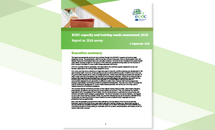Assessment of workforce capacity and training needs for the prevention and control of communicable diseases in the EU/EEA - Report on 2021 survey
This report summarises the results and data of an ECDC survey assessing the workforce capacity, perceived training needs and the relevance of ECDC training in the field of communicable disease prevention and control collected through ECDC’s capacity and training needs assessment survey, 2021. The assessments are repeated every three years and target the European Union (EU) Member States and the European Economic Area (EEA) countries.
Executive Summary
Out of 30 countries invited to participate, ten responded to the Workforce Capacity Assessment Survey and twenty responded to the Training Needs Assessment Survey.
Only a few countries have a mechanism or legal instrument for workforce planning and development in the area of public health and only one of the countries without such a mechanism or legal instrument has a plan to develop one by 2023.
Almost all countries report that they are unable to recruit sufficient staff to work in communicable disease prevention and control, mainly due to lack of qualified applicants, and inadequate salary scales. The major problems identified for retention of staff were an aging workforce leading to retirements, inadequate professional status/job title, inexistent job promotion, lack of job benefits, and inadequate salary scale.
Almost all countries provided an outline of the organisation/structure/staffing of the communicable disease prevention and control service, while data on the enumeration of the workforce were difficult to collect: they are not available as there is no central registry of staff by profession; the responsibilities of staff do not match the professions indicated in the questions, other priorities due to the COVID-19 pandemic did not allow data collection, numbers are not available to the survey recipients as staff working in communicable disease are under the remit of the Ministry of Health.
Almost all countries affirmed that the national public health institute/authority publishes articles on communicable disease prevention and control. Many countries offer training programmes leading to specialisation and training activities for professional development. Some countries also have a set of competencies used for professional development in communicable disease prevention and control, but not always to measure acquisition of individual competency. The ECDC competency frameworks used are the field epidemiologists core competencies, the public health microbiology core competencies and the core competencies for infection control and hospital hygiene professionals. Half of the respondent countries have a regular census/registry of public health workforce.
The countries reported highest training needs in public health emergency preparedness, surveillance, and emergency response. They also indicated that training organised by ECDC is considered as being of added value for all the domains. Topics identified as particularly in need of training were vaccination and vaccine acceptance, and antimicrobial resistance and healthcare associate infections. When enumerating the number of professionals to be trained, a larger number of professionals needed basic and intermediate training than advanced training.
Finally, in the domains of ‘communication and advocacy’ and ‘laboratory systems and methods’, countries indicated that the face-to-face format would be most suitable for continuous professional learning opportunities. For all other domains, respondents said that a blended format was the most suitable, followed by e-learning and face-to-face.
Download
Public health area
Training programmes
ECDC organises various training activities and programmes in the areas of public health.





